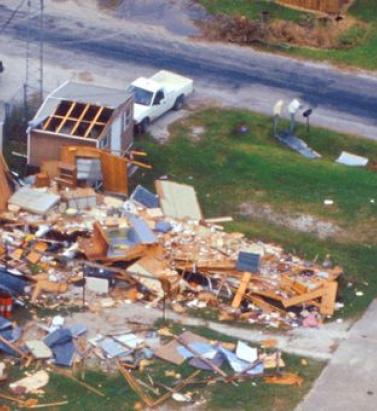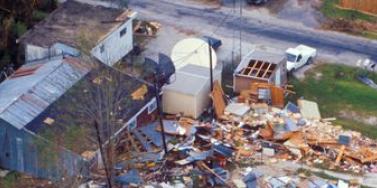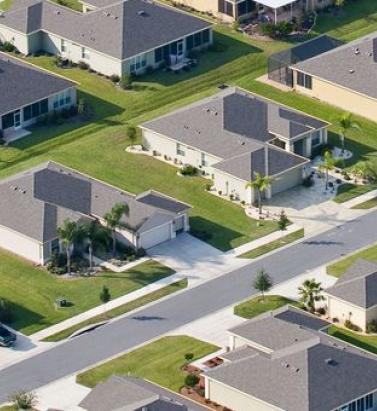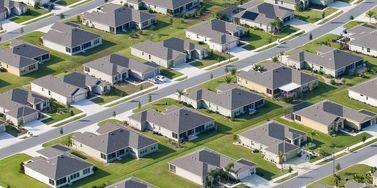Tag: Florida 25 percent rule


Can the Florida Insurance Market Withstand a US$100 Billion Repeat of Hurricane Andrew?
August 23, 2022Hurricane Andrew’s landfall in Florida in 1992 changed the face of property catastrophe insurance and kick-started many new initiatives, including the development of hurricane risk modeling. However, with significant exposure growth, the impact of social inflation, and climate change complications, the insurance market could struggle to respond to a repeat of Andrew. The wide-ranging impact of Hurricane Andrew on the Florida insurance market is a familiar story within the risk management world. However, 30 years on from August 24, 1992, when Andrew made landfall in Dade County, Florida, memories appear to be getting shorter, as the insurance industry once more seems to be in danger of underestimating its exposure to a Category 5 storm hitting the state. Image from the GOES-7 satellite shows Hurricane Andrew at its peak intensity on August 23, 1992, before making landfall near Homestead, Florida. Image source: NOAAWhen Hurricane Andrew came ashore as the first named tropical storm of the 1992 North Atlantic hurricane season, it followed a seven-year hiatus in major hurricane activity in Florida. Industry predictions at the time were that it would cost insurers around US$4 billion to US$5 billion, but Andrew ended up costing the insurance industry US$15 billion (in 1992 values) for Florida claims, and it caused the deaths of 44 people in the state. Following Hurricane Andrew, more than 650,000 claims were filed, leaving eight insurers becoming insolvent and a further three driven into insolvency the following year. Fast forward to today, and RMS® predictions for a repeat of Andrew would see the insured loss for wind and surge in the range of US$80 billion (GR) and US$90 billion (GU), in which other non-modeled losses and social inflation could lead to a US$100 billion event. Aftermath of Andrew The losses from Hurricane Andrew vindicated the need for catastrophe modeling solutions including the use of multiple simulated storms beyond those previously experienced in history. Catastrophe models enabled the new Bermuda reinsurance market: eight new reinsurers were established without the need for their own historical experience. In time, catastrophe models would enable the creation of insurance-linked securities such as catastrophe bonds, to tap into capital markets for alternatives to reinsurance. Without Hurricane Andrew, it might have taken much longer for this revolution to happen. The crisis caused by Andrew certainly precipitated some rapid and innovative changes to help manage a much larger hurricane risk cost than previously recognized, allowing the market to prepare for the hyperactive Florida hurricane seasons of 2004 and 2005. However, the following years were unusually quiet for intense storms landfalling in Florida, encouraging actions that further raised insurers’ hurricane risk costs. Among these was the 25 percent roof replacement rule in 2007, which mandated that if 25 percent or more of a roof is ‘repaired, replaced or recovered’ in any 12-month period, then the entire roofing system or roof section must be brought up to the latest building code. “Until the hurricanes returned with a vengeance in 2017,” says Peter Datin, senior director of modeling at RMS, “the significant additional cost imposed on insurers due to this code update was not clear.” Development of Hurricane Modeling Before Hurricane Andrew, exposure mapping by the insurance industry involved tracking premiums at a fairly coarse ‘Cresta Zone’ resolution. Post-Andrew, as modelers provided insurers with the ability to model exposures at a finer scale, insurers recognized how higher resolution data could provide a more accurate assessment of risk. RMS released its first hurricane model in 1993. Since then, there have been many updates and innovations, from basin-wide stochastic tracks, coupled ocean-atmosphere storm surge modeling, and significant enhancements in damage assessment modeling. After Hurricane Katrina in 2005, Robert Muir-Wood, chief research officer at RMS, coined the term ‘post-event loss amplification’ (PLA) to cover all processes that can raise losses after a major catastrophe, such as demand surge and claims inflation. Auguste Boissonnade, vice president of model development at RMS, who designed the first RMS hurricane model, worked on how to quantify these different factors in generating the overall insurance loss after cat events. Hurricane Katrina floodingFor the most extreme catastrophes, when damage requires the long-term evacuation of large parts of a city, the definition of a “super catastrophe” (or “super-cat”) event applies, where secondary consequences can be a significant component of the original damage. The flooding of New Orleans after Hurricane Katrina was such a super-cat. “With the hurricane catastrophes of 2004 and 2005 came the realization that cat loss models needed to allow for undervaluation of insured exposures as well as the secondary impact of economic, social, and political factors that could amplify the losses,” Boissonnade says. After major hurricanes, RMS vulnerability modelers review lessons that can be learned from the events and the resulting claims data. “Through claims analyses, it has been possible to quantify the degree to which changes in wind design codes have reduced damage and losses to buildings and incorporate those learnings into cat models,” added Datin. Current Market Dynamics The average cost of an annual homeowner’s policy in Florida is expected to soar to US$4,231 this year, almost three times the U.S. annual average, according to the Insurance Information Institute. Five Florida market insurers have already gone insolvent so far in 2022, faced with rising claims costs and increased costs for reinsurance. Meanwhile, the number of policies written by Citizens, a post-Andrew creation, has risen to over a million, as insurers have either gone insolvent, withdrawn capacity from the market, or had their ratings downgraded, making it harder for insureds to secure coverage that will meet their mortgage lenders’ approval. In July 2022, rating agency Demotech wrote to 17 insurers warning them they could be downgraded from A (exceptional) to S (substantial) or M (moderate), potentially impacting millions of policyholders whose mortgage providers demand home insurance from the strongest-rated carriers. Florida legislators then looked to circumvent the use of Demotech ratings with a new stopgap measure, where Citizens take on a reinsurance role to pay claims for insolvent insurers. At the same time, insurers are struggling to secure reinsurance capacity, and Citizens only managed to get a third of its desired reinsurance cover, making it harder for carriers to deploy sufficient capacity to meet the demand for hurricane coverage. There has also been a huge increase in the volume of catastrophe claims in recent years, driven by social inflation and undervaluation of exposures. Likely Impact of Andrew Now “Our prediction that a repeat of Andrew today could cause as much as US$100 billion in insured losses is based in large part on changes in exposure and population since 1992, coupled with updated predictions of the impact of wind and storm surge, with significant anticipated post-event loss amplification. Together these components reveal a more complete picture of potential economic and insured losses,” says Mohsen Rahnama, chief risk modeling officer at RMS. Combined wind and surge losses for a repeat of Hurricane Andrew are estimated at US$87 billion. Post-event loss amplification, whether it is from a slow recovery, supply chain issues from COVID-19, or current inflationary trends, could take the ultimate loss closer to US$100 billion. The impact of storm surge, particularly with the climate change-related rise in sea levels, is also more pronounced now compared to estimates at the time of Andrew. South Florida property developmentAdded to this is the significant demographic shift in Florida. As of this year, the population of Florida is estimated at over 22 million – a 61 percent increase from the number of people in 1992. Building counts in Andrew’s wind and surge footprints have increased by 40 percent to 1.9 million and by 32 percent to 55,000 respectively. Economic exposure has also increased by 77 percent in the wind footprint and 67 percent in the surge footprint. And in Miami-Dade County, the number of high-rise buildings that are over 15 stories has tripled since 1992, many of which are now potentially in Andrew’s surge footprint. “While the wind was the main driver of loss in 1992, the number of new, high-valued buildings near the coast suggests that storm surge losses may play an increasing role in a repeat of this event,” says Rahnama. In constant-dollar terms, economic exposure has grown substantially within both Andrew’s wind and surge footprints, based on an analysis of the total built floor area (see Figure 1). On top of this, cost inflation since 1992 has been substantial, with replacement costs in Florida estimated to have increased between two times and 2.5 times since 1992, based on historical construction cost indices. Figure 1: Exposure growth in Hurricane Andrew’s footprint (in constant dollars). Source: RMSOne key uncertainty in estimating the losses from a repeat of Hurricane Andrew concerns the impact of claims litigation. “Irma in 2017 was the first significant hurricane to make landfall since the 25 percent roof replacement rule was expanded in 2017 to all buildings across Florida, and it contributed to a significant increase in claims frequency and severity, as roof damage sustained during the storm attracted many roofing contractors, who handed over their exaggerated claims to be pursued by attorneys,” recalls Datin. An estimated US$15 billion has been paid to claimants by insurers in Florida since 2013, driven by assignment of benefits (AOB) cases, where litigation has capitalized on the 25 percent roof replacement rule, with a significant portion of the cost being driven by attorney’s fees on both sides. However, a new law passed by the Florida legislature in May 2022 changed the 25 percent roof replacement rule to exempt roofs “built, repaired, or replaced in compliance with the 2007 Florida Building Code, or any subsequent editions of the Florida Building Code.” “This means that only the damaged portion of the roof on newly built or upgraded roofs needs to be repaired after a damaging wind event instead of the entire roof or roofing system. Most importantly for insurers, the right of the contractor or assignee to obtain compensation for attorney fees – that drives up the cost of claims even further – has been removed,” adds Datin. Muir-Wood adds: “There is further hope for insurers following a recent appeal court ruling in Florida which could provide the blueprint for insurers to successfully argue against contractors in such lawsuits. Here we have at least one factor that is now being brought under control, which has significantly raised the insurance costs of hurricane losses. However, insurers will be watching closely to see if there is any reduction in social inflation because of recent legislative measures.” Can the US$100 Billion Repeat of Andrew be Prevented? Should another Category 5 hurricane make landfall in southeast Florida today, not only will the insured loss be more considerable, but the insurance industry will face major challenges that could severely impact its ability to withstand the event. What can the risk management industry do to mitigate losses? Risk modeling has advanced dramatically. “Insurers need to collect detailed data on their exposures and values and then employ high-resolution modeling alongside all those factors that can affect the ultimate loss, whether from post-event loss amplification or from more resilient construction standards,” says Muir-Wood. The spirit of the industry working together with regulators, similar to post-Andrew, needs to be resurrected. “To help insurance carriers to remain competitive, regulators and legislators have been working with the industry to prevent claims litigation from getting out of control and potentially threatening the viability of hurricane insurance in Florida,” adds Boissonnade. “And legislators also need to keep a close eye on how claims respond to the changes to the 25 percent roof replacement rule, and in measures that reduce the need for litigation, so as to reduce vexatious claims,” he adds. Datin acknowledges the role that risk modelers can play, “The catastrophe modeling community has already helped drive positive change in Florida by demonstrating the impacts of building codes and the effects of AOB-driven claims inflation on modeled risk.” In addition, says Rahnama: “It’s crucial that modeling for hurricane risk takes greater account of the effects of climate change on global warming and sea level rise, and the impact those will ultimately on wind and storm surge in the event of another hurricane like Andrew. Let’s not sleepwalk into another Andrew-type scenario. The insights are there, and the warning signs have flashed – we just need to learn from history.”


Deconstructing Social Inflation
September 22, 2021After the loss creep associated with Hurricane Irma in 2017, (re)insurers are keen to quantify how social inflation could exacerbate claims costs in the future. The challenge lies in eliminating the more persistent, longer-term trends, allowing these factors to be explicitly modeled and reducing the “surprise factor” the next time a major storm blows through. A few days after Hurricane Irma passed over Marco Island, Florida, on September 10, 2017, RMS® deployed a reconnaissance team to offer some initial feedback on the damage that was sustained. Most properties on the island had clay tile roofs and while the team noted some dislodged or broken tiles, damage did not appear to be severe. A year later, when Peter Datin, senior director of modeling at RMS, decided to revisit the area, he was shocked by what he saw. “There were so many roofing contractors still on the island, and almost every house seemed to be getting a full roof replacement. We found out that US$900 million worth of roofing permits for repairs had been filed in Marco Island alone.” Trying to find the exact shape and color for tile replacements was a challenge, forcing contractors to replace the entire roof for aesthetic reasons. Then there is Florida's “25 percent rule,” which previously applied to High-Velocity Hurricane Zones in South Florida (Miami-Dade and Broward Counties) before expanding statewide under the 2017 Florida Building Code. Under the rule, if a loss assessor or contractor determines that a quarter or more of the roof has been damaged in the last 12 months, it cannot simply be repaired, and 100 percent must be replaced. This begins to explain why, in the aftermath of Hurricane Irma and to a lesser extent Hurricane Michael in 2018, claims severity and loss creep were such an issue. “We looked at some modeling aspects in terms of the physical meaning of this,” says Datin. “If we were to directly implement an engineering or physics-based approach, what does that mean? How does it impact the vulnerability curve? "We went through this exercise last summer and found that if you hit that threshold of the 25 percent roof damage ratio, particularly for low wind speeds, that's a fourfold increase on your claims. At certain wind speeds, it can therefore have a very material increase on the losses being paid. It’s not quite that straightforward to implement on the vulnerability curve, but it is very significant.” But issues such as the 25 percent rule do not tell the whole story, and in a highly litigious market such as Florida, determining whether a roof needs a complete replacement is not just down to physics. Increasingly, the confluence of additional factors that fall under the broad description of “social inflation” are also having a meaningful impact on the total cost of claims. What Is Social Inflation? Broadly, social inflation refers to all the ways in which insurers’ claims costs rise over and above general economic inflation (i.e., growth in wages and prices), which will influence the cost of repairs and/or replacing damaged property. It therefore captures the growth in costs connected to the following: unanticipated emerging perils associated with, for example, new materials or technologies, shifts in the legal environment, evolving social attitudes and preferences towards equitable risk absorption, and demographic and political developments. (Source: Geneva Association) Florida's “David and Goliath” Law A major driver is the assertive strategies of the plaintiffs' bar, compounded by the three-year window in which to file a claim and the use and potential abuse of practices such as assignment of benefits (AOB). The use of public adjusters and broader societal attitudes towards insurance claiming also need to be taken into consideration. Meanwhile, the expansion of coverage terms and conditions in the loss-free years between 2005 and 2017 and generous policy interpretations play their part in driving up claims frequency and severity. What Is Assignment of Benefits (AOB)? An assignment of benefits, or AOB, is a document signed by a policyholder that allows a third party, such as a water extraction company, a roofer or a plumber to '”stand in the shoes” of the insured and seek payment directly from the policyholder's insurance company for the cost of repairs. AOBs have long been part of Florida’s insurance marketplace. (Source: Florida Office of Insurance Regulation) More recently, the effects of COVID-19 has impacted the cost of repairs, in turn increasing insurers' loss ratios. (Re)insurers naturally want to better understand how social inflation is likely to impact their cost of claims. But determining the impact of social inflation on the “claims signal” is far from simple. From a modeling perspective, the first step is deselecting the different elements that contribute toward social inflation and understanding which trends are longer term in nature. The recently released Version 21 of the RMS North Atlantic Hurricane Models incorporates an alternative view of vulnerability for clients and reflects the changing market conditions applicable to Florida residential lines, including the 25 percent roof replacement rule. However, the effects of social inflation are still largely considered non-modeled. They are removed from available data where possible, during the model development process. Any residual impacts are implicitly represented in the model. “Quantifying the impacts of social inflation is a complex task, partly because of the uncertainty in how long these factors will persist,” says Jeff Waters, senior product manager at RMS. “The question is, going forward, how much of an issue is social inflation really going to be for the next three, five or 10 years? Should we start thinking more about ways in which to explicitly account for these social inflation factors or give model users the ability to manually fold in these different factors? “One issue is that social inflation really ramped up over the last few years,” he continues. “It's especially true in Florida following events like Hurricanes Irma and Michael. At RMS, we have been working hard trying to determine which of these signals are caused by social inflation and which are caused by other things happening in Florida. Certainly, the view of vulnerability in Version 21 starts to reflect these elevated risk factors.” AOB had a clear impact on claims from Irma and Michael. Florida's “David and Goliath” law was intended to level the playing field between policyholders and economically powerful insurers, notes the Insurance Information Institute's Jeff Dunsavage. Instead, the law offered an incentive for attorneys to file thousands of AOB-related suits. The ease with which unscrupulous contractors can “find” damage and make claims within three years of a catastrophe loss has further exacerbated the problem. Waters points out that in 2006 there were only around 400 AOB lawsuits in the market. By 2018, that number had risen to over 135,000. In a decade that had seen very few storms, it was difficult to predict how significant an impact AOB would have on hurricane-related claims, until Irma struck. Of the Irma and Michael claims investigated by RMS, roughly 20 percent were impacted by AOB. “From a claims severity standpoint, the cost of those claims increased up to threefold on average compared to claims that were not affected by AOB," says Waters. Insurers on the Brink The problem is not just limited to recent hurricane events. Due to the Sunshine State's increased litigation, insurers are continuing to face a barrage of AOB non-catastrophe claims, including losses relating to water and roof damage. Reforms introduced in 2019 initially helped rein in the more opportunistic claims, but notifications dialed back up again after attorneys were able to find and exploit loopholes. Amid pressures on the court system due to COVID-19, reform efforts are continuing. In April 2021, the Florida Legislature passed a new law intended to curb market abuse of litigation and roofing contractor practices, among other reforms. Governor Ron DeSantis said the law had been a reaction to “mounting insurance costs” for homeowners. As loss ratios rose, carriers have been passing some of the additional costs back onto the policyholders in the form of additional premiums (around US$680 per family on average). Meanwhile, some carriers have begun to offer policies with limited AOB rights, or none at all, in an effort to get more control over the spiraling situation. “There are some pushes in the legislature to try to curb some of the more litigious behavior on the part of the trial lawyers,” says Matthew Nielsen, senior director, regulatory affairs at RMS. Nielsen thinks the 2021 hurricane season could be telling in terms of separating out some of the more permanent changes in the market where social inflation is concerned. The National Oceanic and Atmospheric Administration (NOAA) still predicts another above-average season in the North Atlantic, but currently does not anticipate the historic level of storm activity seen in 2020. “What's going to happen when the next hurricane makes landfall, and which of these elements are actually going to still be here?” asks Nielsen. “What nobody wants to see again is the kind of chaos that came after 2004 and 2005, when there were questions about the health of the insurance market and what the roles of the Florida Hurricane Catastrophe Fund (FHCF) and Florida Citizens Property Insurance Corporation were going to be.” “Ultimately, we're trying to figure out which of these social inflation signals are going to stick around, and the difficulty is separating the long-term signals from the short-term ones,” he continues. “The 25 percent roof replacement rule is written into legislation, and so that is going to be the new reality going forward. On the other hand, we don't want to include something that is a temporary blip on the radar.”




